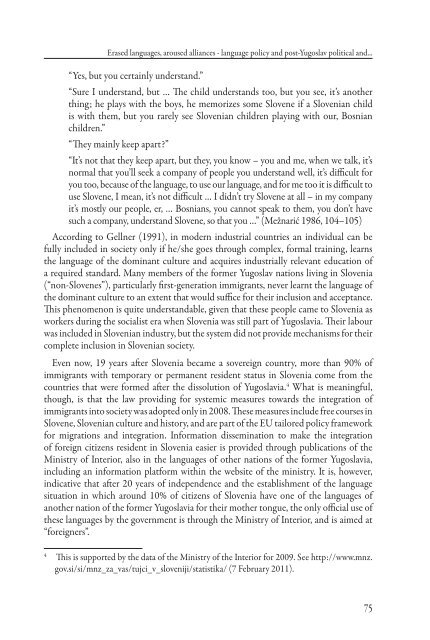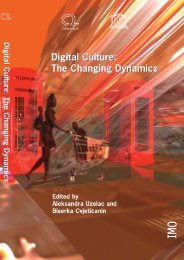free download in pdf format - Culturelink Network
free download in pdf format - Culturelink Network
free download in pdf format - Culturelink Network
Create successful ePaper yourself
Turn your PDF publications into a flip-book with our unique Google optimized e-Paper software.
Erased languages, aroused alliances - language policy and post-Yugoslav political and...<br />
“Yes, but you certa<strong>in</strong>ly understand.”<br />
“Sure I understand, but … Th e child understands too, but you see, it’s another<br />
th<strong>in</strong>g; he plays with the boys, he memorizes some Slovene if a Slovenian child<br />
is with them, but you rarely see Slovenian children play<strong>in</strong>g with our, Bosnian<br />
children.”<br />
“Th ey ma<strong>in</strong>ly keep apart?”<br />
“It’s not that they keep apart, but they, you know – you and me, when we talk, it’s<br />
normal that you’ll seek a company of people you understand well, it’s diffi cult for<br />
you too, because of the language, to use our language, and for me too it is diffi cult to<br />
use Slovene, I mean, it’s not diffi cult … I didn’t try Slovene at all – <strong>in</strong> my company<br />
it’s mostly our people, er, … Bosnians, you cannot speak to them, you don’t have<br />
such a company, understand Slovene, so that you …” (Mežnarić 1986, 104–105)<br />
Accord<strong>in</strong>g to Gellner (1991), <strong>in</strong> modern <strong>in</strong>dustrial countries an <strong>in</strong>dividual can be<br />
fully <strong>in</strong>cluded <strong>in</strong> society only if he/she goes through complex, formal tra<strong>in</strong><strong>in</strong>g, learns<br />
the language of the dom<strong>in</strong>ant culture and acquires <strong>in</strong>dustrially relevant education of<br />
a required standard. Many members of the former Yugoslav nations liv<strong>in</strong>g <strong>in</strong> Slovenia<br />
(“non-Slovenes”), particularly fi rst-generation immigrants, never learnt the language of<br />
the dom<strong>in</strong>ant culture to an extent that would suffi ce for their <strong>in</strong>clusion and acceptance.<br />
Th is phenomenon is quite understandable, given that these people came to Slovenia as<br />
workers dur<strong>in</strong>g the socialist era when Slovenia was still part of Yugoslavia. Th eir labour<br />
was <strong>in</strong>cluded <strong>in</strong> Slovenian <strong>in</strong>dustry, but the system did not provide mechanisms for their<br />
complete <strong>in</strong>clusion <strong>in</strong> Slovenian society.<br />
Even now, 19 years aft er Slovenia became a sovereign country, more than 90% of<br />
immigrants with temporary or permanent resident status <strong>in</strong> Slovenia come from the<br />
countries that were formed aft er the dissolution of Yugoslavia. 4 What is mean<strong>in</strong>gful,<br />
though, is that the law provid<strong>in</strong>g for systemic measures towards the <strong>in</strong>tegration of<br />
immigrants <strong>in</strong>to society was adopted only <strong>in</strong> 2008. Th ese measures <strong>in</strong>clude <strong>free</strong> courses <strong>in</strong><br />
Slovene, Slovenian culture and history, and are part of the EU tailored policy framework<br />
for migrations and <strong>in</strong>tegration. In<strong>format</strong>ion dissem<strong>in</strong>ation to make the <strong>in</strong>tegration<br />
of foreign citizens resident <strong>in</strong> Slovenia easier is provided through publications of the<br />
M<strong>in</strong>istry of Interior, also <strong>in</strong> the languages of other nations of the former Yugoslavia,<br />
<strong>in</strong>clud<strong>in</strong>g an <strong>in</strong><strong>format</strong>ion platform with<strong>in</strong> the website of the m<strong>in</strong>istry. It is, however,<br />
<strong>in</strong>dicative that aft er 20 years of <strong>in</strong>dependence and the establishment of the language<br />
situation <strong>in</strong> which around 10% of citizens of Slovenia have one of the languages of<br />
another nation of the former Yugoslavia for their mother tongue, the only offi cial use of<br />
these languages by the government is through the M<strong>in</strong>istry of Interior, and is aimed at<br />
“foreigners”.<br />
4 Th is is supported by the data of the M<strong>in</strong>istry of the Interior for 2009. See http://www.mnz.<br />
gov.si/si/mnz_za_vas/tujci_v_sloveniji/statistika/ (7 February 2011).<br />
75



